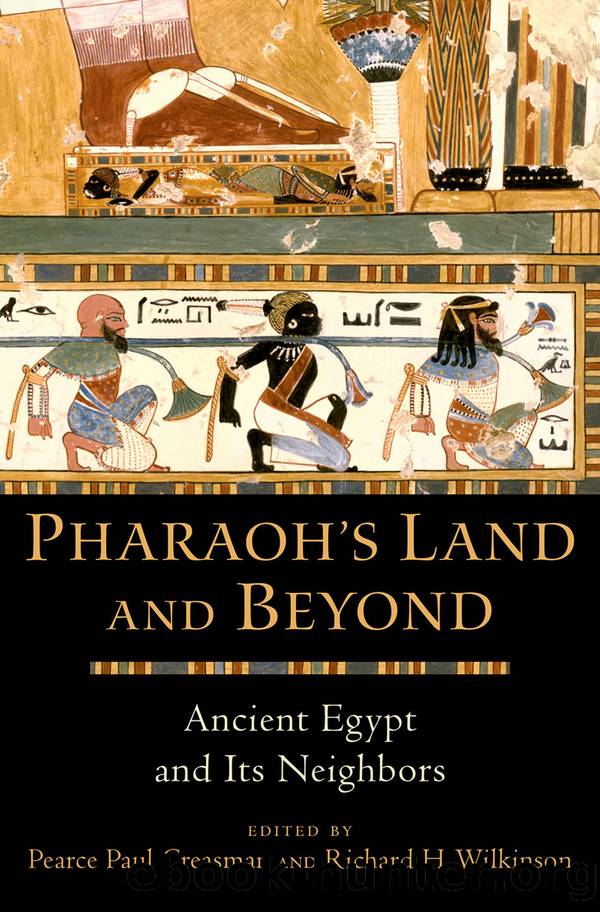Pharaoh's Land and Beyond by Creasman Pearce Paul;Wilkinson Richard H.;

Author:Creasman, Pearce Paul;Wilkinson, Richard H.; [Creasman, Pearce Paul;Wilkinson, Richard H.;]
Language: eng
Format: epub
ISBN: 9780190229078
Publisher: OxfordUP
Published: 2017-09-15T00:00:00+00:00
Innovation in Egyptian Magic and Medicine, and the Role of the âExoticâ
One of the most important debates concerning ancient Egyptian science and technology centers on the question of ancient attitudes to innovation and âprogress.â Were ancient Egyptian doctors open to innovation, or were their methods quintessentially rooted in tradition and previous convention? At least two of the surviving medical papyri, much like some Book of the Dead papyri, specifically refer to their venerable status as documents written by much earlier scribes. This is part of the evidence suggesting that magico-medical texts tended to be evaluated on the basis of their longevity and links with the past, perhaps ultimately accentuating the sense that spells actually worked by drawing on the primordial magic associated with the deities Heka, Hu, and Sia, the three aspects of divine magic. Some of the surviving medical texts, such as the Edwin Smith Papyrus, actually do seem to have been copied from much earlier antecedents. Despite the survival of only fourteen medical texts from a period of two thousand years, the whole genre seems to be based on a large number of lost texts that were much more ancient, or at the very least that was what the reader was intended to believe.
It can also be argued, however, that Egyptian magico-medical texts, while stressing links with longstanding traditions, may also sometimes contain evidence suggesting that some kinds of innovation were allowed. For instance, such phrases as âanother book saysâ suggest deliberate comparisons between different medical ideas, and some choices being made between a variety of techniques and spells. Foreign terms and spells might also be deliberately introduced to improve remedies (e.g., in the London Medical Papyrus). New medical ideas might have emanated from Assyrian and Persian royal courts, as in the case of the demotic Crocodilopolis medical book (Papyrus Vienna 6257; second century ce). The latter includes a large number of plant and mineral ingredients that are not previously mentioned in earlier medical texts, and Robert Ritner has suggested that these pharmaceutical developments might derive from Achaemenid international trade. Similarly, but on a more practical, visual note, the depiction of surgical instruments in the Roman temple at Kom Ombo includes some artifacts that are clearly Roman rather than Egyptian (e.g., scalpels and a sponge). Thus, even within the archaizing and highly traditional world of Egyptian magic and medicine, there are clear signs that innovation was valued.
Download
This site does not store any files on its server. We only index and link to content provided by other sites. Please contact the content providers to delete copyright contents if any and email us, we'll remove relevant links or contents immediately.
The Daily Stoic by Holiday Ryan & Hanselman Stephen(3238)
The Fate of Rome: Climate, Disease, and the End of an Empire (The Princeton History of the Ancient World) by Kyle Harper(3007)
People of the Earth: An Introduction to World Prehistory by Dr. Brian Fagan & Nadia Durrani(2702)
Ancient Worlds by Michael Scott(2627)
Babylon's Ark by Lawrence Anthony(2622)
The Daily Stoic by Ryan Holiday & Stephen Hanselman(2466)
Foreign Devils on the Silk Road: The Search for the Lost Treasures of Central Asia by Peter Hopkirk(2434)
India's Ancient Past by R.S. Sharma(2417)
MOSES THE EGYPTIAN by Jan Assmann(2374)
The Complete Dead Sea Scrolls in English (7th Edition) (Penguin Classics) by Geza Vermes(2237)
Lost Technologies of Ancient Egypt by Christopher Dunn(2195)
The Earth Chronicles Handbook by Zecharia Sitchin(2180)
24 Hours in Ancient Rome by Philip Matyszak(2051)
Alexander the Great by Philip Freeman(2034)
Aztec by Gary Jennings(1977)
The Nine Waves of Creation by Carl Johan Calleman(1884)
Curse Tablets and Binding Spells from the Ancient World by Gager John G.;(1838)
Before Atlantis by Frank Joseph(1814)
Earthmare: The Lost Book of Wars by Cergat(1792)
